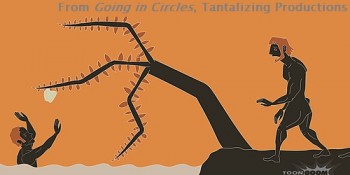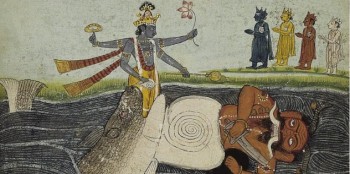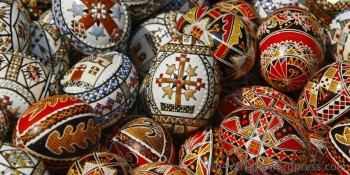The names of provinces in any country can be seen as a road map of the people who lived there: the conquering, the conquered, the vainglorious, and the descriptive. The United States is no different. The East Coast is draped with the names of kings and the poetry of conquistadors, while the northern and western parts of the country are largely sprinkled with indigenous words and phrases that have all but lost their original meanings. Without further ado, let’s have a closer look at this patchwork tapestry.
Alabama is likely from a Choctaw term meaning “plant-cutters.”
Alaska is from the Aleut word alaxsxaq, which means, “the object toward which the action of the sea is directed,” or perhaps more succinctly, “the coastline.”
Arizona is a Spanish transliteration of an O’odham word meaning “having a little spring,” probably not in reference to the Colorado River. The O’odham are an Aztec offshoot that were frequently called Piman by the Spanish. This is probably because, when the Europeans asked them who they were, they replied “pi mac,” which means “I don’t know.” Y’know, because language barrier.
Arkansas is a French transliteration of the word used by the Algonquian peoples to describe the Quapaw, a Sioux tribe that lived on the Arkansas River.
California was named by Spanish explorers after a fictional place in a 1510 novel of Garci (Ordóñez) Rodríguez de Montalvo, whose works are compared to those which make up Arthurian legend. The name may as well be Arrakis or Hogwarts, as the word does not mean anything in particular.
Colorado was named after the Colorado River. The Spanish word simply means “colored,” and implies a reddish, weather-beaten hue.
Connecticut is from the Algonquian quinnitukqut, “at the long tidal river.”
Delaware was named for the first English colonial governor of, ironically, Virginia, Thomas West, 3rd Baron De La Warr. The word is roughly French for “of the war,” or “warrior.”
Florida was discovered by the Spanish in 1513 on Palm Sunday, one name for which is Pascua florida, or “flowering Easter.”
Georgia was named for King George II of Great Britain. As a side note, the Caucasian country Georgia was named for Saint George.
Hawaii is Proto-Polynesian for “place of the gods.”
Idaho is from the Kiowa-Apache word idaahe, meaning “enemy,” used to describe the Comanches.
Illinois comes from an Algonquian tribe who called themselves ilinouek, or “ordinary speaker.”
Indiana was named for the “Indians” in the Americas, who were, of course, not actually from India at all. The word originally derives from Sanskrit sindhu, the same root as the word Hindu, and it means “river.”
Iowa comes from Dakota ayuxba, or “sleepy ones,” describing the Chiwere people who lived there. I feel like we can just name the entire country “Iowa” without much difficulty.
Kansas shares the same root as Arkansas.
Kentucky probably comes from an Iroquoian word meaning “meadow,” something like geda’geh.
Louisiana was named after King Louis XIV of France, deriving from Old High German Hluodowig, “famous in war.”
Maine comes from the name of a French province. The word is Gaulish, probably in reference to “mainland.”
Maryland was named after the wife of King Charles I of England, Henrietta Maria of France.
Massachusetts is Algonquian for “at the large hill,” because there’s a big hill southwest of Boston.
Michigan was named after the lake, probably Old Ojibwe meshi-gami, which means “big lake.” So Lake Michigan is “Lake Big Lake.”
Minnesota is from Dakota mnisota, which means “cloudy water,” in reference to a river.
Mississippi was, of course, named after the river, originally an Ojibwe construction, mshi ziibi, or “big river.” There we go again. The Mississippi River is the “big river river.”
Missouri is from an Algonquian word meaning “people of the big canoes,” in reference to Chiwere tribes from that region.
Montana is just Spanish for “mountain place,” because of all the Rocky Mountains there.
Nebraska is from the Omaha word ni braska, which means “flat river.”
Nevada was named after the Sierra Nevada mountain range on the border. The word is Spanish for “snowy.”
New Hampshire was named after the English county of Hampshire. Hampshire, similar to Hampton, comes from Old English hamtunscir, which simply refers to a village-town and its surrounding farmlands.
New Jersey was named for the Channel Island of Jersey. The word probably either comes from Old Norse jarl (earl) or somebody’s name.
New Mexico was not actually named after the country of Mexico. The state, then a province of New Spain, was named in 1598 — that’s 220 years before Mexico gained independence and named itself. The word is Aztecan mexihco, of unknown origin.
New York was renamed from New Netherland, from when the Dutch East India Company set up shop for the lucrative fur and trading opportunities. It was renamed after British acquisition in honor of future King James II, then Duke of York and Albany. The word York eventually derives from ancient Celtic Eborakon, or “Yew tree estate.”
North Carolina, South Carolina, and Georgia were all one state until the early 1700’s, when governing disagreements caused many of the Lords Proprietor to sell their shares back to the crown. Carolina was named in honor of King Charles I of England (Latin Carolus).
North Dakota was named for the Dakota tribe, who spoke Sioux. Their word, dakhota, means “friendly.”
Ohio was named after the river, with the Seneca word ohiyo, which means “good river.”
Oklahoma is from a Choctaw construction, okla homma, which means “people who are red.” Daniel Snyder is vindicated.
Oregon is probably originally Algonquian, but we don’t know what it means!
Pennsylvania means “Penn’s woods.” Penn is Welsh for “head,” sylvania is Latin for “woods.” It was named not after William Penn, the founder of the colony, but rather his late father, also William Penn. Will wanted to name it “New Wales.” That’d be fun.
Rhode Island was probably an extension of the Dutch name given to Block Island, Roodt Eylandt, or “red island.”
South Carolina shares the same origin as North Carolina.
South Dakota was separated from North Dakota in 1889 on account of population growth. Name origin is shared.
Tennessee is named for a Cherokee village Ta’nasi, the meaning of which is lost.
Texas is a Spanish transliteration of a Caddo word, taysha, which means “friends.” Is it time to change the state’s motto to “I’ll be there for you?” *clap clap clap clap*
Utah is from Western Apache yudah, or “high.” As in mountainous, not as in stoned, considering the large Mormon population. Though Colorado is next door.
Vermont sort of means “green mountain” in French, but the correct form would be “Mont Vert,” so maybe the person who named it didn’t actually know French very well?
Virginia was named, of course, after the Virgin Queen of England, Elizabeth.
Washington was named after George Washington. The word is Old English for “Wassa’s house.”
West Virginia was originally part of Virginia but split during the Civil War.
Wisconsin was named after the river, but the origin of the word is unknown.
Wyoming comes from a region on the other side of the country, in Pennsylvania. It’s from an Algonquian word, chwewamink, which means “at the big river flat.” They named the state Wyoming because they had nothing better to call it, I guess?
So that’s the end of the tour. Hopefully you’ve discovered whether your favorite state is friendly or sleepy or even if you’re a “Jarlsey girl.” See you next week!









